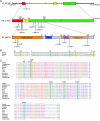Novel THAP1 sequence variants in primary dystonia
- PMID: 20083799
- PMCID: PMC2809032
- DOI: 10.1212/WNL.0b013e3181ca00ca
Novel THAP1 sequence variants in primary dystonia
Abstract
Background: THAP1 encodes a transcription factor (THAP1) that harbors an atypical zinc finger domain and regulates cell proliferation. An exon 2 insertion/deletion frameshift mutation in THAP1 is responsible for DYT6 dystonia in Amish-Mennonites. Subsequent screening efforts in familial, mainly early-onset, primary dystonia identified additional THAP1 sequence variants in non-Amish subjects.
Objective: To examine a large cohort of subjects with mainly adult-onset primary dystonia for sequence variants in THAP1.
Methods: With high-resolution melting, all 3 THAP1 exons were screened for sequence variants in 1,114 subjects with mainly adult-onset primary dystonia, 96 with unclassified dystonia, and 600 controls (400 neurologically normal and 200 with Parkinson disease). In addition, all 3 THAP1 exons were sequenced in 200 subjects with dystonia and 200 neurologically normal controls.
Results: Nine unique melting curves were found in 19 subjects from 16 families with primary dystonia and 1 control. Age at dystonia onset ranged from 8 to 69 years (mean 48 years). Sequencing identified 6 novel missense mutations in conserved regions of THAP1 (G9C [cervical, masticatory, arm], D17G [cervical], F132S [laryngeal], I149T [cervical and generalized], A166T [laryngeal], and Q187K [cervical]). One subject with blepharospasm and another with laryngeal dystonia harbored a c.-42C>T variant. A c.57C>T silent variant was found in 1 subject with segmental craniocervical dystonia. An intron 1 variant (c.71+9C>A) was present in 7 subjects with dystonia (7/1,210) but only 1 control (1/600).
Conclusions: A heterogeneous collection of THAP1 sequence variants is associated with varied anatomical distributions and onset ages of both familial and sporadic primary dystonia.
Figures



Similar articles
-
Genotype-phenotype correlations in THAP1 dystonia: molecular foundations and description of new cases.Parkinsonism Relat Disord. 2012 Jun;18(5):414-25. doi: 10.1016/j.parkreldis.2012.02.001. Epub 2012 Feb 28. Parkinsonism Relat Disord. 2012. PMID: 22377579 Free PMC article. Review.
-
Heterogeneity in primary dystonia: lessons from THAP1, GNAL, and TOR1A in Amish-Mennonites.Mov Disord. 2014 May;29(6):812-8. doi: 10.1002/mds.25818. Epub 2014 Feb 5. Mov Disord. 2014. PMID: 24500857 Free PMC article.
-
THAP1/DYT6 sequence variants in non-DYT1 early-onset primary dystonia in China and their effects on RNA expression.J Neurol. 2012 Feb;259(2):342-7. doi: 10.1007/s00415-011-6196-5. Epub 2011 Jul 29. J Neurol. 2012. PMID: 21800139
-
Genetic screening of THAP1 in primary dystonia patients of India.Neurosci Lett. 2017 Jan 10;637:31-37. doi: 10.1016/j.neulet.2016.11.060. Epub 2016 Nov 29. Neurosci Lett. 2017. PMID: 27913194
-
DYT6 dystonia: review of the literature and creation of the UMD Locus-Specific Database (LSDB) for mutations in the THAP1 gene.Hum Mutat. 2011 Nov;32(11):1213-24. doi: 10.1002/humu.21564. Epub 2011 Sep 15. Hum Mutat. 2011. PMID: 21793105 Review.
Cited by
-
Screening for THAP1 Mutations in Polish Patients with Dystonia Shows Known and Novel Substitutions.PLoS One. 2015 Jun 18;10(6):e0129656. doi: 10.1371/journal.pone.0129656. eCollection 2015. PLoS One. 2015. PMID: 26087139 Free PMC article.
-
Late-Onset Dystonia With THAP1 Mutation (DYT6) in South Korea: A Case Report and Literature Review.J Clin Neurol. 2023 Mar;19(2):198-200. doi: 10.3988/jcn.2022.0241. J Clin Neurol. 2023. PMID: 36854336 Free PMC article. No abstract available.
-
Recent advances in the genetics of dystonia.Curr Neurol Neurosci Rep. 2014 Aug;14(8):462. doi: 10.1007/s11910-014-0462-8. Curr Neurol Neurosci Rep. 2014. PMID: 24952478 Free PMC article. Review.
-
Towards the classification of DYT6 dystonia mutants in the DNA-binding domain of THAP1.Nucleic Acids Res. 2012 Oct;40(19):9927-40. doi: 10.1093/nar/gks703. Epub 2012 Jul 27. Nucleic Acids Res. 2012. PMID: 22844099 Free PMC article.
-
Genotype-phenotype correlations in THAP1 dystonia: molecular foundations and description of new cases.Parkinsonism Relat Disord. 2012 Jun;18(5):414-25. doi: 10.1016/j.parkreldis.2012.02.001. Epub 2012 Feb 28. Parkinsonism Relat Disord. 2012. PMID: 22377579 Free PMC article. Review.
References
-
- Fuchs T, Gavarini S, Saunders-Pullman R, et al. Mutations in the THAP1 gene are responsible for DYT6 primary torsion dystonia. Nat Genet 2009;41:286–288. - PubMed
-
- Djarmati A, Schneider SA, Lohmann K, et al. Mutations in THAP1 (DYT6) and generalised dystonia with prominent spasmodic dysphonia: a genetic screening study. Lancet Neurol 2009;8:447–452. - PubMed
-
- Duane DD. Spasmodic torticollis: clinical and biologic features and their implications for focal dystonia. Adv Neurol 1988;50:473–492. - PubMed
Publication types
MeSH terms
Substances
Grants and funding
- R01 NS037167/NS/NINDS NIH HHS/United States
- P01AG017216-1/AG/NIA NIH HHS/United States
- R01 NS039821/NS/NINDS NIH HHS/United States
- P01AG017216/AG/NIA NIH HHS/United States
- R21 ES017504/ES/NIEHS NIH HHS/United States
- R01 NS041509-09/NS/NINDS NIH HHS/United States
- R01AG015866-1/AG/NIA NIH HHS/United States
- R01NS048458/NS/NINDS NIH HHS/United States
- R01NS058797/NS/NINDS NIH HHS/United States
- P42 ES04696/ES/NIEHS NIH HHS/United States
- U10 NS44455/NS/NINDS NIH HHS/United States
- P30NS05710/NS/NINDS NIH HHS/United States
- R01 HD056015/HD/NICHD NIH HHS/United States
- R01 NS057567-01A2/NS/NINDS NIH HHS/United States
- R01 NS041509/NS/NINDS NIH HHS/United States
- U54 TR001456/TR/NCATS NIH HHS/United States
- 5U01 NS052592/NS/NINDS NIH HHS/United States
- R01 NS050425/NS/NINDS NIH HHS/United States
- P50-NS40256/NS/NINDS NIH HHS/United States
- K24 NS060825/NS/NINDS NIH HHS/United States
- R01 ES013743-01A2/ES/NIEHS NIH HHS/United States
- 5R01 NS037167-10/NS/NINDS NIH HHS/United States
- U54 NS065701/NS/NINDS NIH HHS/United States
- K23 NS43351/NS/NINDS NIH HHS/United States
- UL1 TR000448/TR/NCATS NIH HHS/United States
- R01AG015866/AG/NIA NIH HHS/United States
- R01 NS050425-05/NS/NINDS NIH HHS/United States
- R01ES013743/ES/NIEHS NIH HHS/United States
- P30 NS057105/NS/NINDS NIH HHS/United States
- 1R03NS053840/NS/NINDS NIH HHS/United States
- U10 NS44482/NS/NINDS NIH HHS/United States
- R01 NS058714-03/NS/NINDS NIH HHS/United States
- RR024992/RR/NCRR NIH HHS/United States
- R01 NS058714/NS/NINDS NIH HHS/United States
- 1R01 NS41509/NS/NINDS NIH HHS/United States
- R01HG02449/HG/NHGRI NIH HHS/United States
- P50NS 40256/NS/NINDS NIH HHS/United States
- 1R01NS058988/NS/NINDS NIH HHS/United States
- 1R01NS41509/NS/NINDS NIH HHS/United States
LinkOut - more resources
Full Text Sources
Other Literature Sources
Molecular Biology Databases
Research Materials
